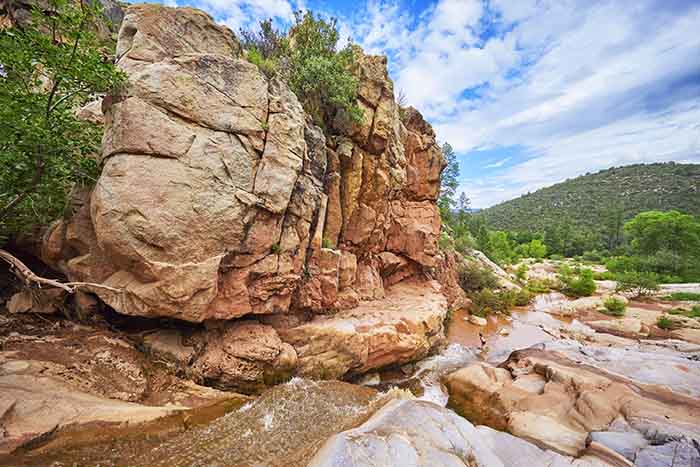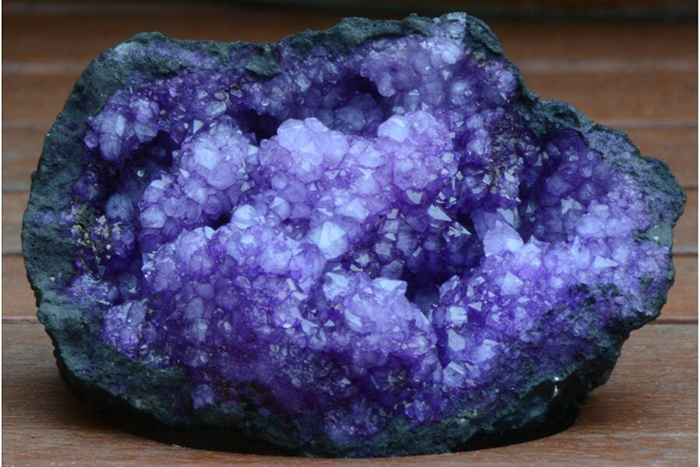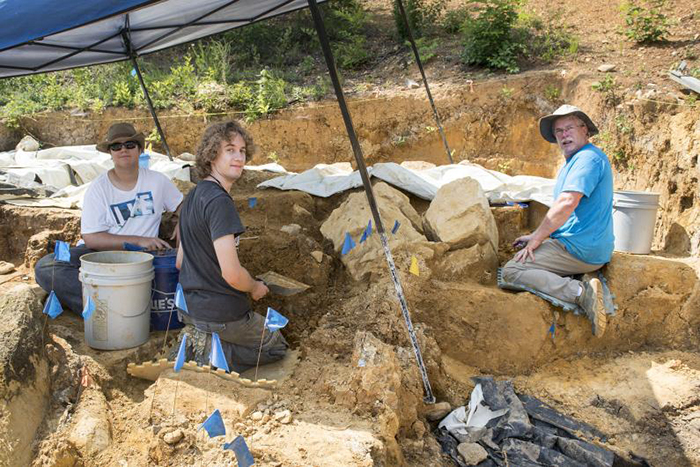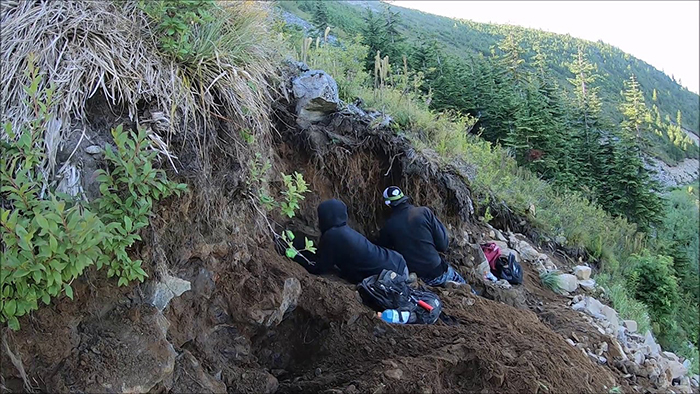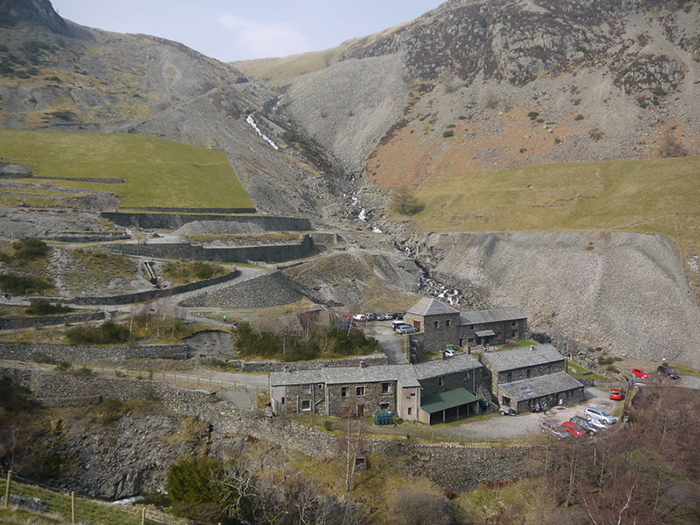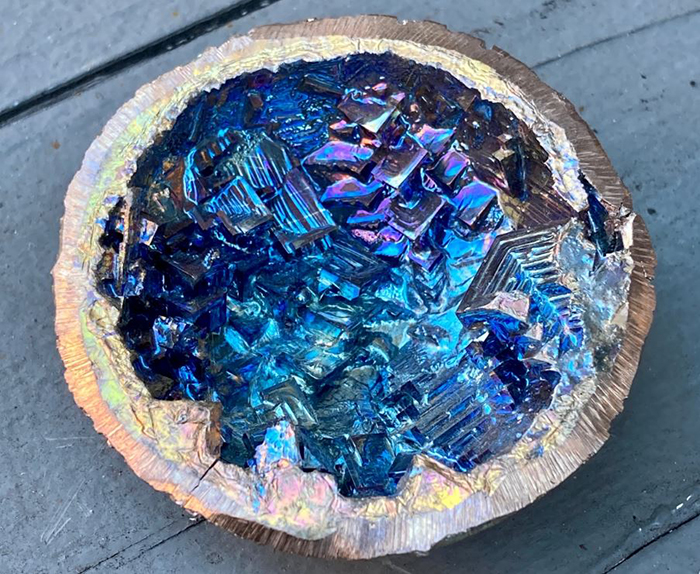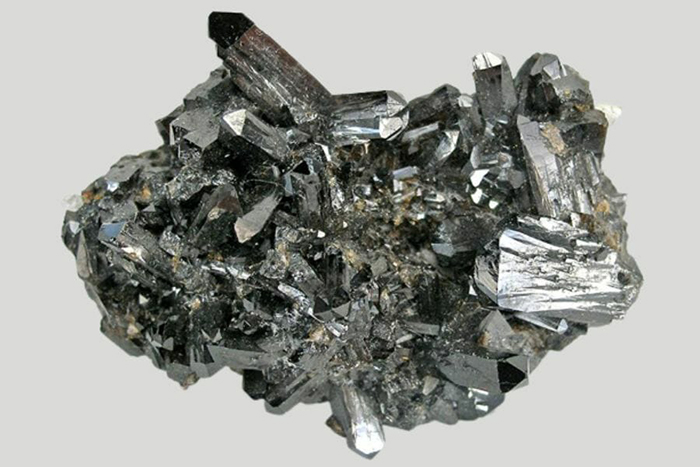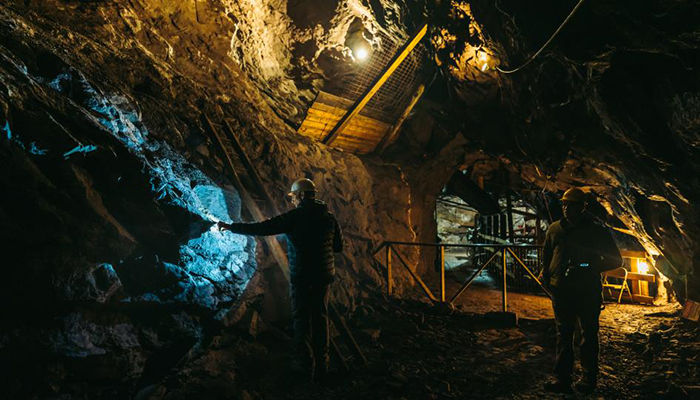Are you wondering if your newly acquired Moldavite is the real deal? Unfortunately, with the recent surge in its popularity, counterfeit versions of this precious gemstone are flooding the market.
To clear up any doubts and help you spot fakes, we have compiled a comprehensive guide to determining Moldavite authenticity. Get ready to become an expert on recognizing genuine Moldavite!
You Are Watching: How to Tell If Moldavite Is Real
Characteristics of Real Moldavite

Real Moldavite can be identified by its distinct characteristics, such as its unique color, rough texture, irregular shape and size, genuine origin from the Czech Republic or Germany, and the presence of natural inclusions.
Color
Genuine Moldavite boasts a unique green hue that varies from pale to dark, often appearing mossy or olive-like. Unlike the bright and uniform color seen in fakes, real Moldavite exudes nuanced coloration due to natural processes over millions of years.
These variations give authenticity to the stone, making it an essential factor in distinguishing genuine specimens from counterfeit ones. Scrutiny under appropriate lighting can reveal these subtle differences which validates your precious gem’s legitimacy.
Texture
Real Moldavite has a distinct texture that can help in determining its authenticity. Genuine Moldavite has a rough, pitted surface with natural indentations and grooves. This unique texture is a result of the stone’s formation during intense heat and pressure from a meteor impact millions of years ago.
Fake Moldavite, on the other hand, often has a smooth or polished texture that lacks the natural imperfections found in real Moldavite. By running your fingers along the surface of a potential Moldavite stone and feeling for these characteristic textures, you can get closer to identifying if it is genuine or not.
Shape
Real Moldavite often has a unique shape that sets it apart from fakes. Genuine Moldavite can be irregularly shaped, with jagged edges and an overall asymmetrical form. This is due to its natural occurrence as a result of meteorite impact.
Fake Moldavite, on the other hand, may have rounded edges or a more uniform shape since it is typically created through acid shaping or molding processes. Evaluating the shape of Moldavite can provide valuable insights into its authenticity.
Size
Determining the size of a Moldavite stone is another important factor in identifying its authenticity. Real Moldavite can come in various sizes, ranging from small chips to larger pieces.
The article suggests that fake Moldavite gemstones are often uniform in size and lack the natural variation found in genuine stones. By examining the size of a Moldavite specimen, buyers can gain further insight into its authenticity and determine if it aligns with the characteristics of real Moldavite mentioned earlier.
Ensuring that the size matches what is expected for authentic Moldavite can help buyers make an informed decision when purchasing this unique gemstone.
Origin
Moldavite, a unique green gemstone, is believed to have originated from the impact of a meteorite in southern Germany about 15 million years ago. This rare gem was formed when intense heat and pressure caused by the meteorite colliding with the Earth transformed the surrounding silica-rich sediments into glass-like material.
As a result, Moldavite is found primarily in areas near this impact site, including parts of Germany and neighboring regions like Austria and the Czech Republic. Its distinct origin story adds to its allure and makes it highly sought after among collectors and enthusiasts alike.
Inclusions
Inclusions are a crucial factor to consider when determining the authenticity of Moldavite. Genuine Moldavite often contains small bubbles or inclusions trapped within the stone, which can be seen under magnification.
These inclusions are formed during the natural process of Moldavite’s creation and help distinguish it from fake counterparts. Fake Moldavite, on the other hand, may lack these characteristic inclusions or have very few bubbles present.
By examining for these distinctive features, you can confidently identify whether your Moldavite is real or not.
Characteristics of Fake Moldavite
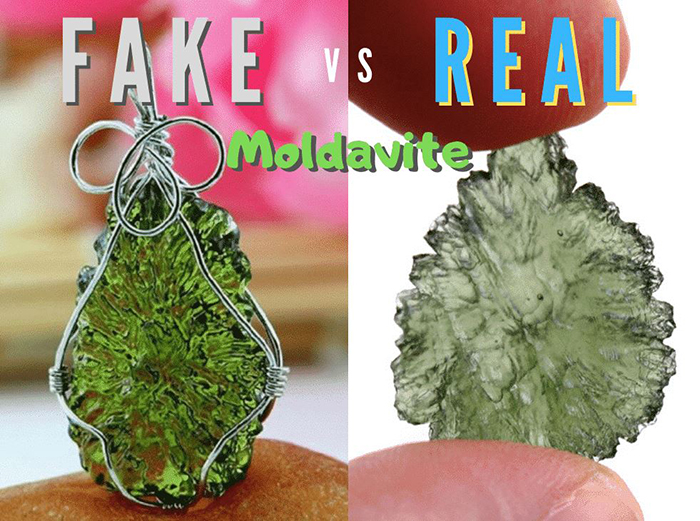
Fake Moldavite can often be identified by the presence of bubbles or inclusions, a uniform appearance without any distinct texture, smooth and polished surfaces, and a significantly lower price compared to genuine Moldavite.
Bubbles or inclusions
Authentic Moldavite stones often contain unique and distinctive bubbles or inclusions. These internal imperfections are a telltale sign of the stone’s natural formation process, as real Moldavite is formed by the intense heat and pressure caused by a meteor impact.
Genuine Moldavite will typically have several small bubbles or “fingerprints” within its structure, giving it a distinct and irregular appearance. Fake Moldavite, on the other hand, tends to have fewer or no bubbles at all, as they are often crafted using artificial methods.
So when examining a potential piece of Moldavite, be sure to look closely for these characteristic internal features that indicate its authenticity.
Uniform appearance
Read More : Geodes in California
Spotting fake Moldavite can be done by observing its uniform appearance. Real Moldavite is known for its unique and irregular shape, with variations in color, texture, and size. Fake Moldavite, on the other hand, often has a uniform and symmetrical appearance that lacks these natural characteristics.
Be cautious of stones that look too perfect or machine-made, as this is often a sign of counterfeit Moldavite. Genuine Moldavite should have an organic and raw feel to it rather than looking polished or mass-produced.
So remember to examine the stone closely for any signs of a uniform appearance when determining its authenticity.
Smooth texture
Real Moldavite is known for its rough and pitted texture, which sets it apart from fake Moldavite. Genuine Moldavite stones have a distinct surface with small bumps and ridges, giving them an organic feel.
On the other hand, fake Moldavite often has a smooth and polished texture that lacks the unique character of the real gemstone. So, when examining a piece of Moldavite, pay attention to its texture – if it feels too smooth or polished, there’s a good chance it may not be authentic.
Remember that genuine Moldavite should have a rough and uneven surface that reflects its natural formation process.
Moldavite: The first term “Moldavite” itself refers to the specific gemstone being discussed in this section. It is relevant as it describes one aspect of identifying authenticity.
Smooth Texture: This sub-heading directly mentions one characteristic of real or fake material (“smooth texture”) being examined in this section.
Surface: The article suggests paying attention to the textural quality (“surface”) when determining authenticity.
Rough: The word “rough” here contrastingly describes how genuine moldavites should feel on touch.
Authenticity Verification – This phrase relates to determining whether a given item is authentic or not.
Distinct Surface- “Distinct surface” refers to unique characteristics apparent by touching an object.
Low price
Fake Moldavite is often priced lower than authentic pieces. While price alone cannot determine the authenticity of Moldavite, it can be a red flag if a piece is significantly cheaper compared to others on the market.
Genuine Moldavite is rare and highly sought after, which contributes to its higher price point. So, if you come across a suspiciously low-priced piece of Moldavite, it’s essential to exercise caution and thoroughly examine its other characteristics to ensure its authenticity.
How to Identify Real Moldavite

To identify real Moldavite, you can compare and contrast its characteristics with those of fake Moldavite, know the seller’s reputation and history, understand the gemstone creation process, and look for authentic certifications.
Compare and contrast
Real Moldavite can be distinguished from fake Moldavite by examining several key characteristics. Real Moldavite will have a darker and more varied color compared to the bright, uniform color of fake Moldavite.
Additionally, real Moldavite will have a unique texture with visible surface irregularities, while fake Moldavite will typically feel smooth. In terms of size and shape, real Moldavite can vary greatly due to its natural formation process, whereas fake Moldavite often has consistent shapes and sizes.
Finally, authentic Moldavite comes from the Czech Republic or Germany, while fake versions may claim to come from other locations. By comparing these characteristics, you can confidently identify genuine moldavite stones.
Know the seller
To ensure the authenticity of your Moldavite, it is crucial to know and trust the seller. Take the time to research their reputation and credibility before making a purchase. Look for sellers with positive reviews, certifications, or affiliations with reputable gemstone associations.
Be cautious when buying online, as counterfeit Moldavite can often be found on platforms like Etsy. By choosing a trustworthy seller, you can increase your chances of purchasing genuine Moldavite and avoid falling victim to scams or misrepresentations.
Knowing about the seller’s background and reputation is an essential step in determining the authenticity of Moldavite. It allows you to make an informed decision and minimizes the risk of purchasing fake stones.
Understand the gemstone creation process
The gemstone creation process is essential to understand when determining the authenticity of Moldavite. Genuine Moldavite is formed through meteorite impact, as a result of intense heat and pressure over millions of years.
This unique creation process gives real Moldavite its distinct characteristics, such as its rough texture, irregular shape with rounded edges, and natural color variations. By understanding how genuine Moldavite is formed, you can better identify fake stones that may lack these key features.
Look for authentic certifications
Read More : Gem Mining In New York
Authentic certifications are a crucial factor to consider when determining the authenticity of Moldavite. These certifications provide added assurance and credibility, indicating that the stone has been tested and verified by reputable gemstone laboratories.
One widely recognized certification is from the Gemological Institute of America (GIA), which thoroughly examines and assesses Moldavite for its authenticity. By looking for these authentic certifications, buyers can have confidence in their purchase and ensure that they are getting genuine Moldavite.
Tools for Identifying Authenticity
To accurately verify the authenticity of Moldavite, use personal examination, handheld X-ray analyzers, and microscopes. These essential tools provide detailed insights into the gemstone’s color, texture, shape, and internal structure.
Discover how these tools can help you determine if your Moldavite is genuine or counterfeit by reading more on our comprehensive guide.
Personal examination
To determine the authenticity of Moldavite, personal examination is crucial. When examining a Moldavite stone, it is important to observe its color, texture, and shape. Authentic Moldavite typically has a darker and more varied color compared to fake ones that have a bright and uniform appearance.
Additionally, real Moldavite usually has a rough texture with natural imperfections such as bubbles or inclusions. It may also have irregular shapes with rounded edges due to acid shaping during its formation process.
By personally inspecting these characteristics, you can make a better judgment on the authenticity of the Moldavite gemstone without solely relying on external factors or certifications.
Handheld X-Ray Analyzer
A handheld X-Ray Analyzer is a valuable tool for determining the authenticity of Moldavite. This device allows you to examine the internal structure of the stone and identify any inconsistencies or signs of manipulation.
By using an X-Ray Analyzer, you can easily spot fake Moldavite that may have been created through acid shaping or other artificial methods. This powerful tool provides a non-destructive way to verify the authenticity of your Moldavite, giving you confidence in your purchase.
Microscope
Using a microscope is another effective tool for identifying the authenticity of Moldavite. By examining the stone under a microscope, you can closely observe its internal structure and details that may not be visible to the naked eye.
This can help you determine if it has any inclusions or bubbles, which are common indicators of a fake Moldavite. A genuine Moldavite will have a unique and distinct structure, with natural imperfections that add to its authenticity.
So, when assessing the Moldavite’s characteristics, don’t forget to utilize a microscope for a more detailed examination.
Avoiding Scams and Misconceptions
To avoid scams and misconceptions, trust your instincts, thoroughly research the seller and their reputation, and exercise caution when purchasing Moldavite online.
Trust your instincts
When it comes to determining the authenticity of Moldavite, trust your instincts. While there are various characteristics and tests to consider, sometimes your gut feeling can be a reliable indicator.
Pay attention to how the stone feels in your hand and any intuitive reactions you may have when examining it. Your instincts can often pick up on subtle differences that may not be easily discernible through visual inspection alone.
So, listen to yourself and let your intuition guide you when making a decision about the authenticity of Moldavite.
Research the seller and their reputation
To ensure that you are purchasing authentic Moldavite, it is crucial to research the seller and their reputation. Look for reviews or feedback from other buyers who have purchased Moldavite from the same seller.
A reputable seller will have positive ratings and testimonials attesting to the authenticity of their products. Avoid sellers with negative feedback or complaints about selling fake stones.
By conducting thorough research on the seller and their reputation, you can increase your chances of obtaining genuine Moldavite for your collection or jewelry piece.
Be cautious of buying online
When purchasing Moldavite, it is important to exercise caution when buying online. Due to its increasing popularity, there has been a rise in counterfeit and fake Moldavite being sold on various platforms.
To ensure you are getting an authentic stone, be sure to research the seller and their reputation before making a purchase. Look for sellers who have positive reviews and a track record of delivering genuine gemstones.
Additionally, consider buying from reputable websites or dealers who specialize in gemstones and provide certifications of authenticity. By taking these precautions, you can avoid falling victim to scams and ensure that you are getting a genuine piece of Moldavite for your collection or jewelry.
Conclusion
In conclusion, determining the authenticity of Moldavite is an essential step for buyers. By carefully examining its color, texture, shape, and inclusions, and considering factors like origin and price, it becomes easier to distinguish real Moldavite from fake.
With the right tools and knowledge, buyers can confidently identify genuine Moldavite and avoid scams or misconceptions in the market.
Sources: https://memo-mag.com
Category: Guide

